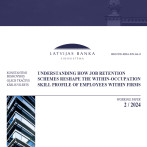Robust job creation reflects labour market recovery
The labour survey data of the Central Statistical Bureau (CSB) point to a further recovery of the Latvian labour market, which is reflected not only in dropping unemployment but also in increased employment.
Jobseekers rate in the last quarter of 2012 was 13.8% of the economically active population, dropping by 1.2 percentage points year-on-year. We predicted such a result before. The view that unemployment is dropping only because of people leaving the country does not reflect reality. On the contrary, the number of economically active population is growing[1] and thus a higher unemployment is observed with the particular number of jobs. Even though the increase in the economically active population is a positive phenomenon and it reflects the greater hopes people have of finding a job, it must be kept in mind that in the short term, it worsens unemployment statistics. If the number of economically active population had not increased over the past two years, jobseekers rate now could be close to 11%.
The most convincing indication of the recovery of the Latvian labour market is employment dynamics. The rise in employment in Latvia is the fastest in the European Union, underpinned by all available sources (of varied inclusivity) of statistics. Thus the possibility that the recovery of the labour market is taking place "only on paper" or under the influence of some short-term factor is excluded. To wit: according to the labour survey data published by the CSB today, the number of the employed grew by 25.6 thousand year-on-year. A similar rise has taken place according to the data of the State Revenue Service, which, in contrast to the labour survey, exclude the grey economy: the number of employees paying the social security contributions grew by 23.0 thousand. The latest data available from other employment statistics sources cover the third quarter of 2012. According to the CSB business survey data, the number of jobs in the country grew by 31.2 thousand year-on-year and it was determined by developments in the private sector. The national account data point to the increase in the number of employees (by 23.0 thousand) as the main factor behind the increased employment (29.8 thousand year-on-year).
Albeit different researchers tend to evaluate natural unemployment differently, it is clear that the high unemployment in Latvia is primarily a structural problem, which has existed for two decades whereas the current drop in unemployment is primarily a cyclical phenomenon. Any further success in reducing unemployment will thus be increasingly less related to the broad demand stimulating programmes and will increasingly more depend on the effectiveness of employment programmes targeted at certain groups of population and certain regions of the country.
[1] Due to the participation rate ( economically active to working age population ratio).
Textual error
«… …»




